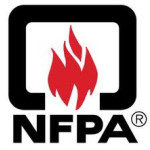- Industry: Fire safety
- Number of terms: 98780
- Number of blossaries: 0
- Company Profile:
Established in 1896, NFPA's mission is to reduce the worldwide burden of fire and other hazards on the quality of life by providing and advocating consensus codes and standards, research, training, and education.
The loading of a ship’s bunker or tank with fuel oil for use in connection with propulsion or auxiliary equipment.
Industry:Fire safety
The interior finish of floors, ramps, stair treads and risers, and other walking surfaces.
Industry:Fire safety
The load for which a given piece of equipment or manufactured system was engineered for under normal static conditions.
Industry:Fire safety
The material(s) utilized in a rocket motor that produces thrust by the discharge of a working fluid generated by combustion, decomposition, change of state, or other operation of such material contained within the rocket motor.
Industry:Fire safety
The lateral distance between the centerlines of the tires at ground; if there are dual rear wheels, the lateral distance from the midway points between the inner and outer tires at ground.
Industry:Fire safety
The maximum concentration of an airborne contaminant to which one can be exposed; the ceiling limits used are those published in 29 CFR 1910. 1000.
Industry:Fire safety
The inrush current of a solenoid is the steady-state current taken from the line at rated voltage and frequency with the plunger blocked in the rated maximum open position.
Industry:Fire safety
Системы автоматического водяного пожаротушения предназначены для автоматического распределения воды в целях тушения пожара или предотвращения его распространения.
Industry:Fire safety
В дренчерной системе пожаротушения применяются незаполненные (сухие) трубопроводы. Дренчерные насадки не имеют тепловых замков; в нормальном состоянии вода не заполняет систему благодаря наличию дренчерного клапана. При открытии дренчерного клапана все насадки срабатывают одновременно, обеспечивая быстрое затопление защищаемого помещения. Применяются для защиты особо пожаро- и взрывоопасных объектов, а также в качестве дренчерных завес, которые отсекают «стеной огнетушащего вещества» (например воды) помещение, где возникло возгорание, от других помещений здания.
Industry:Fire safety
